Activity 1.17. Develop an understanding of the pest complex in La Trinidad strawberry fields with an emphasis on spider mites.
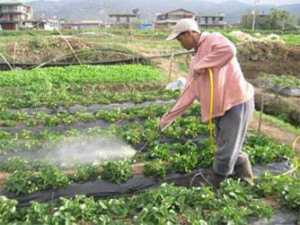 The feasibility of using a power-washer as a mechanical method for removing spider mites was tested. Initial results showed the power washer is capable of removing over 50% of the spider mites. Although it also removed the predatory mites, they reappeared the following week. Additional testing is needed to determine its usefulness as a substitute for a chemical knockdown spray prior to the release of predatory mites. Potential negative side effects such as issues with pollination and increased fungal diseases are also being evaluated.
The feasibility of using a power-washer as a mechanical method for removing spider mites was tested. Initial results showed the power washer is capable of removing over 50% of the spider mites. Although it also removed the predatory mites, they reappeared the following week. Additional testing is needed to determine its usefulness as a substitute for a chemical knockdown spray prior to the release of predatory mites. Potential negative side effects such as issues with pollination and increased fungal diseases are also being evaluated.
A seasonal pest calendar was produced as a first step in the production of a strategic management plan for the strawberry industry of La Trinidad. Primary pests include twospotted spider mites, Tetranychus urticae, armyworm/cutworm, Spodoptera spp. slugs, thrips, aphids and hemipterans (Lygus sp.). The pest calendar will facilitate monitoring and pest biofix, reducing unnecessary chemical applications. The calendar will promote combination control strategies for those pests appearing at the same time, minimizing pesticide applications.
Specimens of Spodoptera were collected and provided to Dong Ariba at IRRI for identification, testing and development of an effective SpNPV strain. The S. exigua SpNPV looks promising and may prove to be the right selection for the Spodoptera complex occurring in March. It is possible that S. litura may also be present earlier in the season then possibly overlapping with S. exigua. Further testing is needed to verify these observations. Currently the armyworm/cutworm complex in La Trinidad is the most disruptive pest to the use of predatory mites with these pests accounting for 61% of chemicals applied to their fields.
Activity 1.18. Mass rearing Neoseiulus longispinosus, a native predatory mite.
The addition of a 1/10 hp vacuum pump has reduced handling time necessary for collection of predatory mites prior to release. 2000 mites can now be collected in 50 minutes as compared to three hours, prior to the use of the vacuum pump.
Matching funds provided by the provincial government resulted in the hiring of 3 laboratory assistants and payment of the rearing laboratory electricity for 6 months. Both the provincial and the municipal governments realize our project is the only way to change the minds of the farmers regarding pesticide usage. Because they value this USAID IPM CRSP project, they have provided additional funds to supplement the project and to encourage sustaining the use of predatory mites. They provided funds for additional manpower in the rearing laboratory that allowed us to release over 33,000 Neoseiulus longispinosus in the interagency demonstration trials. These predators were reared on field collected spider mite prey.
Adequate and timely supply of prey for the mass rearing of N. longispinosus is the primary “bottleneck” in their production. Spider mites found on the castor bean plant, Ricinus communis were found to be a useful alternative food for the predatory mite colonies until the Sablan greenhouse is fully operational.
The provincial government has just constructed a (11’x 17’) greenhouse in Sablan as a field insectary to rear twospotted spider mite prey as a food source for the predatory mite colonies. This will mean a substantial savings in time and provide a reliable food source for increasing predatory mite production numbers. We can now regulate augmentation of N. longispinosus for mass releases during the most critical infestation period, October–December when new strawberry transplants are most affected by spider mites.
Eleven farmers were instructed with the technique for rearing predatory mites with our “clay-pot” method. They will be able to supplement our mass releases with their own trickle releases (weekly) or they can make releases in ‘hot spots’ to control early season populations.
A predatory mite rearing-manual is in preparation and publication is planned this year. This publication will be particularly useful for developing countries interested in producing moderate numbers of predatory mites with local materials. There is no such manual currently available.
Activity 1.19. Demonstrate IPM techniques to strawberry growers.
We conducted pesticide bioassays with chlorfenapyr, (Kotetsu™), to determine its effects on N. longispinosus. A list of additional pesticides and fungicides currently being applied on La Trinidad strawberry will be tested resulting in identification of chemicals most compatible with the survival and safety of N. longispinosus.
A demo-field interagency meeting was conducted on 14 January 2009. Participants representing 7 agencies and the 11 farmer cooperators were present. Discussions focused on clarification of agency roles and farmer questions.
A farmer training session on 29 January 2009 provided an opportunity for the 11 farmer cooperators and interagency collaborators to visit the rearing laboratory. Farmers received basic training on differentiating between pest and predatory mites, information on their life cycles and hands-on opportunities to use the research equipment such as the mite brushing machine, the mite washing machine and the vacuum pump to collect live predatory mites. This event promoted an appreciation for the predatory mites and an understanding of how samples are taken and analyzed.
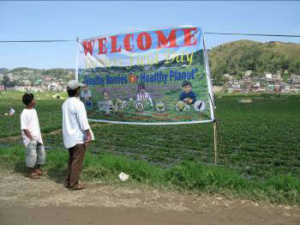 Weekly meetings (12 meetings) were held with OBSPA (Organic Based Strawberry Producers Association) who make up the 11 farmer/cooperators in the Interagency Swamp Demo. Weekly data representing spider mite averages and predatory mites recovered in both the release and non-release areas were presented to our cooperators. These spreadsheet summaries, graphs and comments provide farmers with guidance and comparative effects from their weekly practices. Additional information and discussions on beneficial insects and pests collected in the fields were presented to the group.
Weekly meetings (12 meetings) were held with OBSPA (Organic Based Strawberry Producers Association) who make up the 11 farmer/cooperators in the Interagency Swamp Demo. Weekly data representing spider mite averages and predatory mites recovered in both the release and non-release areas were presented to our cooperators. These spreadsheet summaries, graphs and comments provide farmers with guidance and comparative effects from their weekly practices. Additional information and discussions on beneficial insects and pests collected in the fields were presented to the group.
A “Farmer Field Day” held 30 March provided an opportunity for over 80 participants from the community including interested public, other farmers and technical specialists to meet and interact with one another. The local television station, ABS-CBN out of Baguio City highlighted the predatory mites and farmers interacting with visiting farmers. Farmer testimonials from three of the demonstration cooperators all strongly supported the use of predatory mites and resultant decreases in pesticide usage. Representatives from the newspapers, The Midland Courier, Sunstar and Inquirer and the local government radio station, Radyo Bayan covered the event. Garry Mateo received a cash award for being selected the IPM Farmer for the 2008-2009 strawberry season. This combination of activities increased public awareness of the benefits of biological control of spider mites with predatory mites.
Activity 1.20. Farmer’s handling and release of predatory mites.
Farmer cooperators were taught correct handling and release of predatory mites in their own fields.
Activity 2.4. Investigation into improved marketing, techniques and value added products.
An advertising campaign linking the use of predatory mites with reduced pesticides and healthier food was implemented. The slogan is catching on in the community, providing a mechanism to sustain the use of predatory mites beyond the end of the project. Government officials find it a satisfying message and one easy to promote as was evident from the speeches presented during the Farmer Field Day.
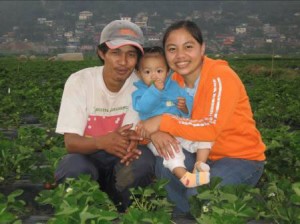 In La Trinidad, strawberry farming is a family affair and the strawberry fields commonly serve as playgrounds for their children. This provides powerful imagery and support for advertising that links all of these elements. Showcasing the farmer’s own children in the strawberry fields stirs a farmer’s protective instincts to reduce pesticides in order to protect themselves, their families and the consumers. The idea of using predatory mites becomes inseparable from that of good stewardship of his crop as well as his family.
In La Trinidad, strawberry farming is a family affair and the strawberry fields commonly serve as playgrounds for their children. This provides powerful imagery and support for advertising that links all of these elements. Showcasing the farmer’s own children in the strawberry fields stirs a farmer’s protective instincts to reduce pesticides in order to protect themselves, their families and the consumers. The idea of using predatory mites becomes inseparable from that of good stewardship of his crop as well as his family.
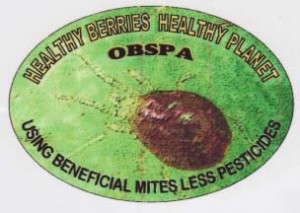 An advertising campaign promoting the use of predatory mites as a niche market opportunity for farmers was launched. The advertising campaign included the production of a sticker identifying strawberries grown using predatory mites to biologically control spider mites. Placards posted in fields where predatory mites are used and press releases highlighting the technology and raising the public awareness of the function of predatory mites and their role in reducing pesticides. Developing a market for their strawberries built around the use of predatory mites will sustain their use and the longevity of the project.
An advertising campaign promoting the use of predatory mites as a niche market opportunity for farmers was launched. The advertising campaign included the production of a sticker identifying strawberries grown using predatory mites to biologically control spider mites. Placards posted in fields where predatory mites are used and press releases highlighting the technology and raising the public awareness of the function of predatory mites and their role in reducing pesticides. Developing a market for their strawberries built around the use of predatory mites will sustain their use and the longevity of the project.
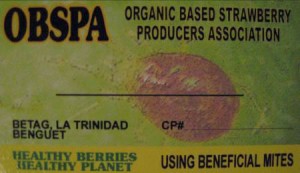 The strawberry fields are a popular tourist destination in La Trinidad. Tourists enjoy walking along paths separating each farmer’s field that furthermore provides an opportunity for farmers to sell and make potential market contacts. Calling cards were provided to all farmer cooperators to capitalize on this opportunity. The cards provide a method of advertising and a professional touch to assist farmers in acquiring new markets for their exclusive product, particularly high-end markets offering them premium prices.
The strawberry fields are a popular tourist destination in La Trinidad. Tourists enjoy walking along paths separating each farmer’s field that furthermore provides an opportunity for farmers to sell and make potential market contacts. Calling cards were provided to all farmer cooperators to capitalize on this opportunity. The cards provide a method of advertising and a professional touch to assist farmers in acquiring new markets for their exclusive product, particularly high-end markets offering them premium prices.
The feasibility of a pilot project is being investigated that would introduce a new value added product and the technology for dehydrating strawberries to women of the community. These women are enthusiastic for innovating new, competitive strawberry productions during the off-season to enhance their incomes. Presently, strawberry jam is overproduced and selling at a low price.
Activity 2.5. Economic Support for Using Predatory Mites
The eleven farmer cooperators involved in the interagency demonstration project were instructed on how to keep detailed records on inputs, including chemicals applied, labor, soil amendments, yield and other economic data needed for us to compare predatory mite release areas and non-release economic impacts.
An economic survey was handed to all of the farmer cooperators. Eight of the eleven farmers returned the economic survey. All eight reported a reduction in acaricide and insecticide usage as a direct result of the project. Four of the eight surveys reported a 54% average reduction in acaricides and insecticide/acaricides in the predatory mite release blocks compared to the non-release blocks. One farmer provided specific information on inputs for the year. He reported that insecticide/acaricides represent 42% of all chemicals applied. According to the farmer, total pesticides represent approximately 10% of all his inputs for the season. These statistics presented by the farmers indicate that using predatory mites has already resulted in a substantial savings and next year with the implementation of the correct SpNPV the savings can be even more significant. Statistical analyses for our economic survey data and the chemical and biological control of spider mites and insects will be completed for the final progress report in September.